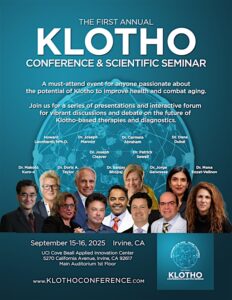Dr Joseph Maroon Lectures at First International Klotho Conference

Photo Dr. Maroon with Dr. Makoto Kuro-o In 1997 Dr. Kuro-o discovered the klotho gene and protein. He showed that it increases lifespan, keeps arteries healthy, lowers blood pressure and supports brain memory and cognitive function by decreasing neurodegeneration. He has been proposed for the Nobel Prize in physiology and medicine for his discovery
Press Release. Sept 24, 2025 Dr. Joseph Maroon was invited to present his research and that of his associates, Pravat Mandal, PhD, and Zach Spears, MS, at the first International Klotho Conference on the “Future of Klotho Based Therapies and Diagnostics.”
In 1997 Dr. Makoto Kuro-o (see Image) discovered the Klotho protein that slowed aging and when increased was protective against many of the diseases of aging He traveled from Japan to be the keynote speaker for this inaugural conference. Many believe he will receive a Nobel Prize for discovering the gene that may extend lifespan, keep arteries healthy, lowers blood pressure and supports brain cognitive function. In mythology, Klotho was one of the three fates responsible for spinning the thread of human life.

Dr. Maroon’s presentation was entitled, “Magnetic Resonance Spectroscopy and the Role of Klotho, Glutathione and Oxidative Stress in Alzheimer’s, Parkinson’s and Traumatic Brain Injury.” Other presenters spoke on the protective effects of Klotho in cancer, joint health, cardiovascular disease, kidney disease and evolving strategies to increase it. Speakers participated from several European countries and South America. An international audience attended virtually. Dr. Dena Dubal, a neurologist and neuroscientist, and the David Coulter Endowed Chair in Aging and Neurodegenerative Disease at UCSF, described the protective effects of Klotho in Alzheimer’s and other neurodegenerative diseases. Many of the attendees remarked Klotho is one of the best kept “secrets” in medicine at the present time—but not for long!
AI Assisted Background on Klotho
Klotho is a protein and gene that plays a major role in regulating aging, metabolism, and overall health. The Klotho gene (KL) was first discovered in mice in 1997. Mice lacking this gene showed signs of premature aging (shorter lifespan, osteoporosis, vascular calcification, skin atrophy). Mice with extra copies of the gene lived longer than normal.
As a protein the Klotho protein is mainly produced in the kidneys and brain. Klotho circulates in blood and cerebrospinal fluid, with hormone-like functions. by regulating calcium and phosphate balance (important for bone health), protecting against oxidative stress and cellular damage. It also supports cognitive function (higher levels are linked to better memory and learning). influences insulin sensitivity and energy metabolism and is associated with longer lifespan and healthier aging in animal models. Klotho can be thought of as a “longevity protein” that helps keep the body’s systems balanced and slows down the processes of aging.
References:
Mutation of the mouse klotho gene leads to a syndrome resembling ageing — Kuro-o et al. (1997)
-
This is the foundational discovery paper. It describes how disruption of the klotho gene in mice causes a phenotype that mimics many aspects of accelerated aging: short lifespan, osteoporosis, skin atrophy, arteriosclerosis, emphysema, infertility, etc. Nature+1
-
The klotho protein was characterized as a transmembrane protein with homology to β-glucosidase enzymes. Nature+1
-
This paper established klotho as a gene critical for normal aging and viability in mammals.
Access: Published in Nature (1997, Vol. 390, pp. 45–51). Nature+2PubMed+2
2. Life extension factor Klotho enhances cognition — Dubal et al. (2014)
-
This is one of the first papers showing that raising Klotho levels improves cognitive function in mice. PubMed+2PMC+2
-
It also shows that a human KL-VS variant (a polymorphism) is associated with higher serum Klotho and better cognitive performance in heterozygous carriers. PubMed+2Klogenix+2
-
Mechanistically, the study linked Klotho to enhancements in long-term potentiation (LTP) and upregulation of the GluN2B subunit of NMDA receptors, and further demonstrated that blocking GluN2B eliminates the Klotho effect. Klogenix+2PMC+2
Access: Cell Reports, May 22, 2014; DOI: 10.1016/j.celrep.2014.03.076. PubMed+2Klogenix+2
3. Longevity factor klotho enhances cognition in aged nonhuman primates — Castner et al. (2023)
-
This is a more recent, high-impact translational advance: it tests whether Klotho can enhance cognition in nonhuman primates (rhesus macaques)—a model more closely related to humans. Nature+2Europe PMC+2
-
They found that a single low-dose administration of Klotho improved memory performance in aged monkeys (in hippocampal / spatial working memory tasks). Nature+2Europe PMC+2
-
The dose is important: high doses did not produce benefit (suggesting a therapeutic window). Europe PMC+1
-
This work supports the idea that Klotho’s positive effects on cognition may translate into primates / humans.
Access: Nature Aging (2023). DOI: 10.1038/s43587-023-00441-x. Nature+2Europe PMC+2




 Dr. Maroon received an athletic scholarship to Indiana University in Bloomington, Indiana where as an undergraduate, he was named a Scholastic All-American in football. Dr. Maroon has successfully maintained his personal athletic interests through participation in 9 marathons and more than 72 Olympic-distance triathlon events. However, his greatest athletic accomplishment is his participation in 8 Ironman triathlons (Hawaii – 1993, 2003, 2008, 2010, 2013; Canada – 1995; New Zealand – 1997; Germany – 2000), where he usually finishes in the top 10 of his age group. Recently, in July 2012 and 2013, he finished second and third, respectively, in his age group in the Muncie, Indiana half Ironman triathlon. In October 2013 he completed his 5th World Championship Ironman in Kona, Hawaii.
Dr. Maroon received an athletic scholarship to Indiana University in Bloomington, Indiana where as an undergraduate, he was named a Scholastic All-American in football. Dr. Maroon has successfully maintained his personal athletic interests through participation in 9 marathons and more than 72 Olympic-distance triathlon events. However, his greatest athletic accomplishment is his participation in 8 Ironman triathlons (Hawaii – 1993, 2003, 2008, 2010, 2013; Canada – 1995; New Zealand – 1997; Germany – 2000), where he usually finishes in the top 10 of his age group. Recently, in July 2012 and 2013, he finished second and third, respectively, in his age group in the Muncie, Indiana half Ironman triathlon. In October 2013 he completed his 5th World Championship Ironman in Kona, Hawaii.